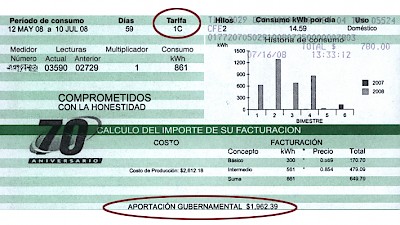Saving Energy in the Yucatan
If you live here, you know about the CFE: La Comisión Federal de Electricidad. But no one calls it CFE here in Mexico. They call it by its first name only: Comisión, and everyone knows who they are talking about. Electricity is the most expensive utility in Mexico, at least among the expat crowd. Comisión has a great website, where they proudly proclaim, in both English and Spanish, that they are una empresa de clase mundial (A world class company). On the website, you can learn about their mission, find out the weather all over Mexico, read the history of the Comisión (did you know that as late as 1937, there were three different companies providing power in Mexico?), read their financial statements, and of course, pay your bill. Oh, oops! You can't pay your bill there... but they will refer you to a bank (Banamex, Banorte, Inbursa, Bancomer, HSBC or Santander) where you CAN pay your bill online. Of course, there is much MORE information on the Spanish side of the website, but really, the fact that there is an English website at all is rather impressive.
Usually, we have no occasion to read the website. We pay our bills, in cash usually, and we are grateful for reliable electricity. But the other day, due to personal circumstances, we learned something about electricity consumption here in Mexico, and we thought we'd pass it on. This is not something we would have ever known if we hadn't moved from one house to another and noticed a big change in our electric bill.
In our old office, we worked in a traditional colonial home that had been renovated. Due to a lack of windows, we ran two mini-split air conditioners all day, every day while we were working. We had a small refrigerator. We regularly paid bi-monthly bills of $8,000 pesos or more during the summer months. We figured this was just the cost of doing business.
Flash forward to our new home and office combined. We built this building with air flow in mind. We built higher ceilings, a second story, skylights that open, and a breezeway, so consequently, we have less need for air conditioning, even during the hottest summer days. In addition, this house and office are almost completely new: new walls, new wiring, new fixtures. Electricity flows unimpeded by faulty connections or old wiring. Our appliances are all new, so we have energy-efficient air conditioners and refrigerators (yes, we have two refrigerators). The house and office combined are at least three times larger than the former house and office, and yet the CFE bills have been less than a third of our former bills.
(Insert mental picture of us quizzically scratching our heads...)
We were extremely grateful for this... but also puzzled. We looked at the meter... yep, the right meter number is on our bill. The meter is turning. The reading on the bill is correct. We were a little afraid to ask, but we called CFE to understand why our new bills are so much lower. Here is what we learned:
If a house uses over 850 kilowatt hours (kWh) of electricity per month, averaged over a year, it will get bumped from the "1C" Tarifa (rate) to the "DAC" Tarifa (De Alto Consumo, which means "of high consumption"). Once this happens, your rate climbs in three ways. First, DAC customers are charged a minimum of $65 pesos per month. Secondly, the Basico (basic) charge for DAC consumers increases from about $0.5 to $2.5 pesos per kilowatt hour (summer prices). The third whammy (that's the technical term in English for golpe) is that the government does not give you an Aportación Gubernamental (Government Subsidy). That aportación can underwrite more than two thirds of your bill every month, which is certainly not trivial. Take a look at our last bill, below, for reference.
If you find yourself still categorized 1C, know that you have to stay under 850 kilowatt hours of average energy consumption per month every year. You'll enjoy lower energy prices and a government subsidy if you do. If you use more than that for twelve months running, then be prepared for much higher energy bills and no subsidy. If you find yourself already in the DAC category, what can you do? Cut your energy costs down to under 850 kilowatts per month for 12 months, and the CFE computers will (supposedly) lower your rates automatically. If they don't, here's what you can do: Take another look at the copy of the bill below. See the column titled, Consumo kWh por dia? Multiply that number by 365 and divide by 12. That's your average monthly consumption. If the number is less than 850, chances are you qualify, so take a stroll down to La Comisión and ask them to change your Tarifa back to 1C.
If these policies aren't motivation for cutting energy consumption, we don't know what is.
ADDENDUM:
In investigating this issue, we have learned more about how CFE charges.
CFE rates each city in Mexico according to its average temperature. Merida is a "1C" city, whereas Chelem, por ejemplo (for example) is a 1B city, meaning it's average temperature is lower (in this case) and warrants less energy usage. The chart below shows the level of Kilowatts per month that the consumer must stay below in order to avoid being charged as a DAC (de alto consumo) customer.
1 up to 250 Kwh/month
1A up to 300 Kwh/month
1B up to 400
1C up to 850
1D up to 1000
1E up to 2000
1F up to 2500
To explain, if you live in Chelem (a 1B city), then you have to keep your consumption below 400 kilowatts per month in order to keep your 1B designation (and your lower rates and your government subsidy). If you live in Merida, you get to consume up to 850 kilowatts per month before moving to the DAC designation.
Any questions?
Editor's Update: We recently followed a Google ad to this wonderful YouTube page sponsored by CFE. It's in Spanish, but even if you don't understand it all, you will certainly get that CFE and Mexico are beginning a campaign to teach Mexican children about saving energy. Viva Mexico!
Website of Comisión Federal de Electricidad











Comments
paula from toronto 16 years ago
What is the CFE rating of Progreso? 1 or 1A or 1B
Thanks for the great article. P.
Reply
Yucatan Living - Yucatan News: Little Bits Here and There 16 years ago
[...] Summer Electric Rates to End Oct. 10 For those who are unaware of this practice, the Federal Electric Commission has a system with a number of different stratifications. You could be toddling merrily along and, without using any more energy than you did the year before, all of a sudden find yourself with huge electric bills… or, wouldn’t this be nice? …with a bill that drops and you don’t know why. The CFE is currently warning residents that the summer rates end on Oct. 10 and to be mindful of how much electricity they are using, just in case their additional charges end up costing them way more than they expected. For a better understanding of these electric rates, see our article on Saving Energy in the Yucatan. [...]
Reply
Michelle 16 years ago
Hi
I was wondering if you could give me some information on CFE billing in the Puerto Vallarta area. We are very careful with our energy useage but this summer has been very hot and we have used our A/C more. Our energy usage during the winter months is much lower than the summer. How do they average this?
any infor would be much appreciated,
Michelle
Reply
Steve Creagh 16 years ago
I am surprised that people do not convert to a battery bank and solar system. A 8 golf cart battery bank has approximately 1000 amps available at 12 volts. Since it is usually and easier on the batteries to only use half that leaves you with 500 available amps. Solar panels come in various sizes and the ones we have on our sailboat are 64 watts apiece x 2 and in the summer in canada we can put back in about 40 amps per day to the battery bank as well as power all the boats electrical needs which includes a top loading fridge freezer, water pumps, radios etc. all our lighting is LED and an equivelent 20 watt halogen in LED only draws .1 amp at 12 volts and the new LED's come in warm white. We have an inverter for any 120 volt demand we might have. Since the Yucatan sits under bright blue sky most of the time, I have to wonder why people don't add a solar system and supplement it with local power when needed on cloudy days or do away with local power entirely.
cheers
Reply
Jon Commiato 16 years ago
Most houses in Mexico are made with concrete block with an R-value close to single pane glass. This contributes to the high energy usage with A/C. Also block has good thermal mass meaning the heat built up during the day has to fought by A/C's only used at night. I am having my house retrofitted with studs for spray foam insulation and sheetrock. Hopefully this will tackle the problem of high energy usage. Also don't forget those who pay for their electricity pay for others that don't.
Reply
Yucatan Living - Yucatan News: Improvements Everywhere 16 years ago
[...] Summer Charges on Electricity Set to Begin For many expats, their electrical bill remains somewhat of a mystery. We received information saying that our area uses the National CFE’s chart 1-C, so we looked online and found their site. You can actually get month-by-month rates and see how much the rate changes at the basic rate (up to 150) kwh, intermediate rates (151 to 300 kwh), and greater rates (over 350 kwh). Try it out. One thing you will notice is that summer rates are higher - all the way to October, when they go back down to winter rates. The change isn’t much, but please do play with that site a bit to see what leaving lights and other electricity-gobbling appliances on can do to your bill. While we were on the CFE website, we found another page that might help when you are considering what to leave on - and what to turn off - around the house. Click here to see approximately how many kwh each of your electrical necessities and entertainment toys actually uses and the potential add-on to your electric bill. For more information on how your CFE bill works, check out our article on CFE. [...]
Reply
kathy 17 years ago
Most excellent article, Ellen. Now that we're buying in Merida it is time to peruse your site again. I was keeping up daily until we moved to Quintana Roo. One of the forums there has linked this article and what a GREAT piece of work it is!
We walked by La Casa del Panadero the other day (we were staying close to the MEL) and it looks absolutely worth each and every peso of electricity.
Oh, I also followed your directions to Wayan'e and we LOVED the fillings and the salsas were the absolute BEST we've ever had. Can't wait to become Meridianos. :)
Reply
CFE Summer Rates Are Over - In The Roo Forums 17 years ago
[...] is a fascinating article about how CFE calculates rates: Yucatan Living - Saving Energy in the Yucatan. ~Cheri __________________ Tony & Cheri Luna Blue Hotel & Garden Playa del Carmen, [...]
Reply
jt 17 years ago
I don't know what 8.000 pesos is worth but not far from where you used to live the rates are on the moon.. i paid $ 573.00 this month. (bet thats a few pesos huh?)..(gosh i dislike P.G.and E., I unplugged one of the 3 fridges i have today..the lg. freezer still runs ..lol..), and am trying to go solar and designing a system that makes power forever for free... for me and friends... not the public... knowing you are a electronics's genius I need your help in designing a item unrelated to power usage please email me back ok... and i hope all is well there...j
Reply
CFE Summer Rates Are Over - In The Roo Forums 17 years ago
[...] is a fascinating article about how CFE calculates rates: Yucatan Living - Saving Energy in the Yucatan. ~Tony & Cheri Luna Blue Hotel & Garden Playa del Carmen, [...]
Reply
L. Fair 17 years ago
How common are solar panels in Merida? Are they used at all on roof tops and, if so, do they contribute to or decease any (possible) leakage from the roof? Thanks for any reply! L.F.
Reply
« Back (20 to 31 comments)Next »